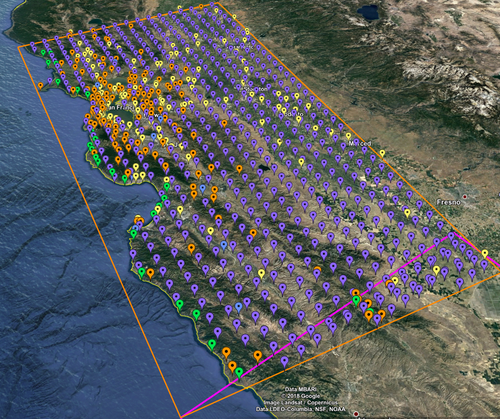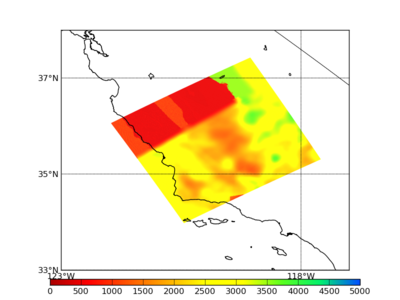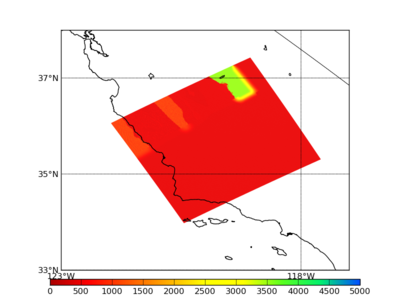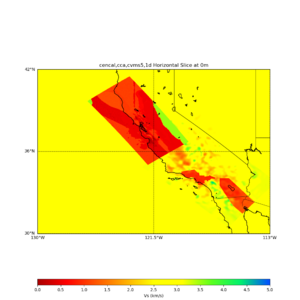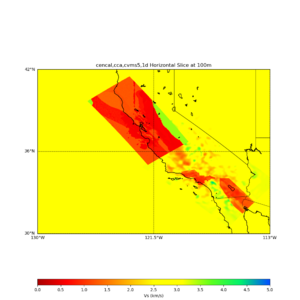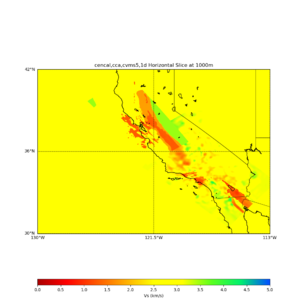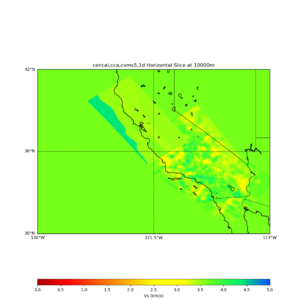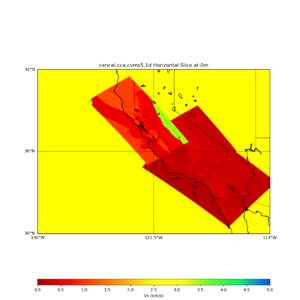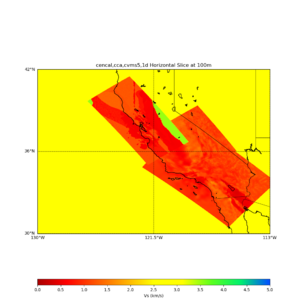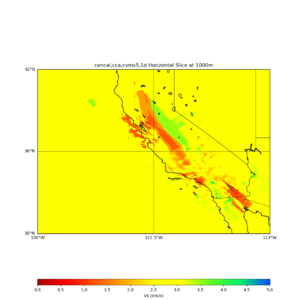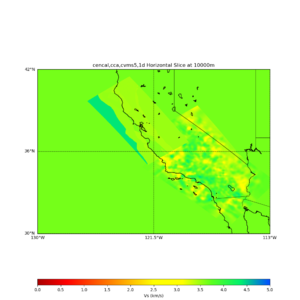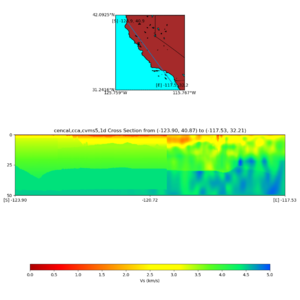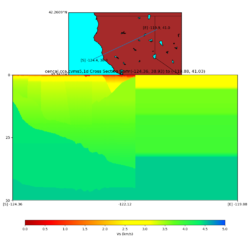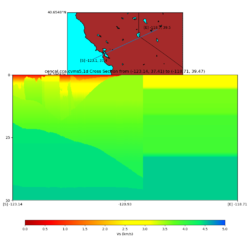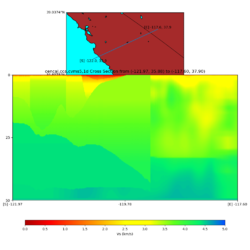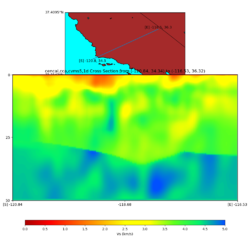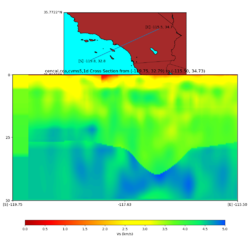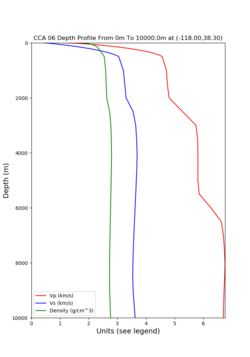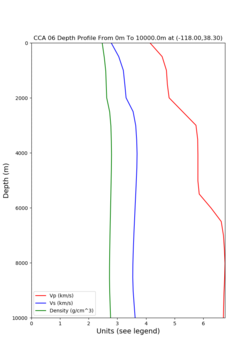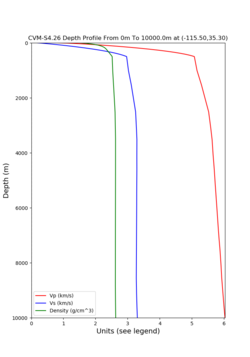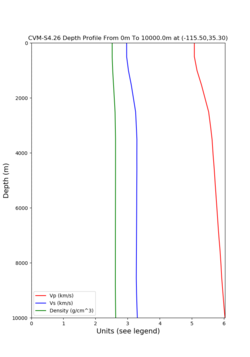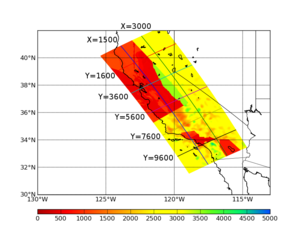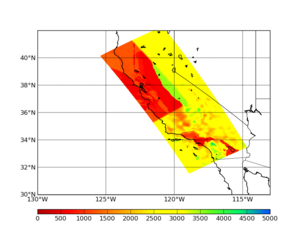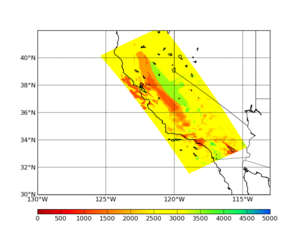CyberShake Study 18.8
CyberShake 18.3 is a computational study to perform CyberShake in a new region, the extended Bay Area. We plan to use a combination of 3D models (USGS Bay Area detailed and regional, CVM-S4.26.M01, CCA-06) with a minimum Vs of 500 m/s and a frequency of 1 Hz. We will use the GPU implementation of AWP-ODC-SGT, the Graves & Pitarka (2014) rupture variations with 200m spacing and uniform hypocenters, and the UCERF2 ERF. The SGT and post-processing calculations will both be run on both NCSA Blue Waters and OLCF Titan.
Contents
- 1 Status
- 2 Science Goals
- 3 Technical Goals
- 4 Sites
- 5 Projection Analysis
- 6 Velocity Models
- 7 Verification
- 8 Background Seismicity
- 9 Performance Enhancements (over Study 17.3)
- 10 Output Data Products
- 11 Computational and Data Estimates
- 12 Production Checklist
- 13 Presentations, Posters, and Papers
- 14 Related Entries
Status
This study is under development. We hope to begin in May 2018.
Science Goals
The science goals for this study are:
- Expand CyberShake to the Bay Area.
- Calculate CyberShake results with the USGS Bay Area velocity model as the primary model.
- Calculate CyberShake results at selection locations with Vs min = 250 m/s.
Technical Goals
- Perform the largest CyberShake study to date.
Sites
The Study 18.3 box is 180 x 390 km, with the long edge rotated 27 degrees counter-clockwise from vertical. The corners are defined to be:
South: (-121.51,35.52) West: (-123.48,38.66) North: (-121.62,39.39) East: (-119.71,36.22)
We are planning to run 869 sites, 838 of which are new, as part of this study.
These sites include:
- 77 cities (74 new)
- 10 new missions
- 139 CISN stations (136 new)
- 46 new sites of interest to PG&E
- 597 sites along a 10 km grid (571 new)
Of these sites, 32 overlap with the Study 17.3 region for verification.
A KML file with all these sites is available with names or without names.
Projection Analysis
As our simulation region gets larger, we needed to review the impact of the projection we are using for the simulations. An analysis of the impact of various projections by R. Graves is summarized in this posting:
Velocity Models
For Study 18.5, we have decided to construct the velocity mesh by querying models in the following order:
- USGS Bay Area model
- CCA-06 with the Ely GTL applied
- CVM-S4.26.M01 (which includes a 1D background model).
We will use a minimum Vs of 500 m/s. Smoothing will be applied 20 km on either side of any velocity model interface.
A thorough investigation was done to determine these parameters; a more detailed discussion is available at Study 18.5 Velocity Model Comparisons.
For Study 18.3, the first velocity model, we examined was the following order of precedence:
- USGS Bay Area model
- CCA-06
- CVM-S4.26.M01 which include a 1D background model
We will apply a minimum Vs of 500 m/s. We will smooth to a distance of 10 km either side of a velocity model interface. A KML file showing the model regions is available here.
We had originally planned to query them in the order 1) USGS Bay Area; 2) CVM-S4.26.M01; 3) CCA-06; 4) 1D background; but upon inspection of the cross-sections, CCA-06 seems to capture the Great Valley basins better than CVM-S4.26, leading to better agreement with the southern edge of the USGS Bay Area model. We are investigating adding the Ely GTL to the CCA-06 model to compensate for the lack of low-velocity, near-surface structure in CCA-06, since the tomographic inversion was performed at 900 m/s.
An alternative velocity model, under consideration for this simulation is based on tiling the models in the following order:
- USGS Bay Area model
- CCA-06 with Ely GTL
- CVM-S4.26 with Ely GTL
- BBP 1D model
Forward simulations
To check the smoothing region, we performed forward simulations near the USGS/CCA-06 boundary, in a volume 270 x 300 x 50 km. The corners of the region are:
-120.5,34,0 -121.93426,36.12917 -118.98101,37.41772 -117.60821,35.25771
For our first test, we selected the CyberShake event ERF ID 36, source ID 60, rupture ID 3, rupture variation 13, a south-to-north M6.95 on the Cholame segment of the San Andreas. We ran with a minimum Vs of 500 m/s, dt=0.005, nt=20000, so 100 sec of simulation time. A visualization of the results is available here; the USGS Bay Area region is in green, and the CCA-06 region is in red. Note that the USGS region has a GTL but the CCA region does not.
For our second test, we selected an individual point in the above CyberShake event and simulated a point source about 20 km SW of the model interface, with the same simulation parameters (minimum Vs of 500 m/s, dt=0.005, nt=20000, so 100 sec of simulation time). A visualization is available here; the USGS Bay Area region is in green, and the CCA-06 region is in red. Note that the USGS region has a GTL but the CCA region does not.
We added the Ely GTL to the CCA-06 model for this region and reran the point-source simulation (with additional filtering). A visualization is available here.
Below are plots comparing the surface without and with the Ely GTL on CCA-06.
Since we saw some refraction effects with the 10 km smoothing, we also tried running with 20 km smoothing, which shows reduced refraction effects. A visualization is available here: [1]
Finally, we did a finite fault simulation across the model interface. We ran ERF 36, source 81, rupture 3, a M7.05 on the San Andreas, the Parkfield and Cholame segments, using the 20 km smoothing. A visualization is available here.
Alternative Velocity Model Plots
We have updated the CyberShake 18.5 velocity model to tile USGS Bay Area, CCA06, and CVM-S4.26, and a 1D background model. Also we have added the Ely GTL to the models. Then, we extracted horizontal cross-sections at 0 km, 0.1 km, 1 km, and 10 km. The 0 km cross-section also indicates the vertical cross-section locations. The following plots represent a proposed Northern California Velocity Model. There is no smoothing between models in these plots. Smoothing will be done to the final selected collection of CVMs.Thes plots were created using an updated version of the UCVM Software,which is available on a development branch in the ucvmc github repository.
The tiling order of velocity models in these plots is:
Science Name (ucvmc abbreviation):
- USGS Bay Area Model (cencal)
- CCA06 (cca)
- CVM-S4.26 (cvms5)
- Modified Hadley Kanamori 1D (1d)
Tiled without adding Ely-Jordan GTL to CCA06 or CVM-S4.26
Tiled with Ely-Jordan Vs30-based GTL added to CCA06, and CVM-S4.26
Tiled with Ely-Jordan Vs30-based GTL added to CCA06 and CVM-S4.26
Depth profiles of 2 selected points:
- Point in CCA06 Model (38.3 -118.0 ):
- Point in CVM-S4.26 (35.3 -115.5) :
Original Vs cross-sections
We have extracted horizontal cross-sections at 0 km, 0.1 km, 1 km, and 10 km. The 0 km cross-section also indicates the vertical cross-section locations.
We extracted vertical cross-sections along 5 cuts parallel to the x-axis:
- Y index=1600: (38.929900, -124.363400) to (41.030000, -119.880200)
- Y index=3600: (37.413200, -123.140900) to (39.470700, -118.713500)
- Y index=5600: (35.884300, -121.967300) to (37.900400, -117.598200)
- Y index=7600: (34.344500, -120.838200) to (36.319900, -116.529600)
- Y index=9600: (32.794700, -119.750000) to (34.730300, -115.503600)
The southeast edge is on the left side of the plots.
and 2 cuts parallel to the y-axis:
- X index=1500: (40.866500, -123.900300) to (32.207800, -117.529700)
- X index=3000: (41.579900, -122.388500) to (32.844200, -116.127900)
The northwestern edge is on the left of the plots.
Verification
Blue Waters/Titan Verification
Overlapping sites
Background Seismicity
Statewide maps showing the impact of background seismicity are available here: CyberShake Background Seismicity
Performance Enhancements (over Study 17.3)
Responses to Study 17.3 Lessons Learned
- Include plots of velocity models as part of readiness review when moving to new regions.
We have constructed many plots, and will include some in the science readiness review.
- Formalize process of creating impulse. Consider creating it as part of the workflow based on nt and dt.
- Many jobs were not picked up by the reservation, and as a result reservation nodes were idle. Work harder to make sure reservation is kept busy.
- Forgot to turn on monitord during workflow, so had to deal with statistics after the workflow was done. Since we're running far fewer jobs, it's fine to run monitord population during the workflow.
We set pegasus.monitord.events = true in all properties files.
- In Study 17.3b, 2 of the runs (5765 and 5743) had a problem with their output, which left 'holes' of lower hazard on the 1D map. Looking closely, we discovered that the SGT X component of run 5765 was about 30 GB smaller than it should have been, likely causing issues when the seismograms were synthesized. We no longer had the SGTs from 5743, so we couldn't verify that the same problem happened here. Moving forward, include checks on SGT file size as part of the nan check.
We added a file size check as part of the NaN check.
Output Data Products
Below is a list of what data products we intend to compute and what we plan to put in the database.
Computational and Data Estimates
Computational Estimates
In producing the computational estimates, we selected the four N/S/E/W extreme sites in the box which 1)within the 200 km cutoff for southern SAF events (381 sites) and 2)were outside the cutoff (488 sites). We produced inside and outside averages and scaled these by the number of inside and outside sites.
We also modified the box to be at an angle of 30 degrees counterclockwise of vertical, which makes the boxes about 15% smaller than with the previously used angle of 55 degrees.
We scaled our results based on the Study 17.3 performance of site s975, a site also in Study 18.3, and the Study 15.4 performance of DBCN, which used a very large volume and 100m spacing.
| # Grid points | #VMesh gen nodes | Mesh gen runtime | # GPUs | SGT job runtime | Titan SUs | BW node-hrs | |
|---|---|---|---|---|---|---|---|
| Inside cutoff, per site | 23.1 billion | 192 | 0.85 hrs | 800 | 1.35 hrs | 69.7k | 2240 |
| Outside cutoff, per site | 10.2 billion | 192 | 0.37 hrs | 800 | 0.60 hrs | 30.8k | 990 |
| Total | 41.6M | 1.34M |
For the post-processing, we quantified the amount of work by determining the number of individual rupture points to process (summing, over all ruptures, the number of rupture variations for that rupture times the number of rupture surface points) and multiplying that by the number of timesteps. We then scaled based on performance of s975 from Study 17.3, and DBCN in Study 15.4.
Below we list the estimates for Blue Waters or Titan.
| #Points to process | #Nodes (BW) | BW runtime | BW node-hrs | #Nodes (Titan) | Titan runtime | Titan SUs | |
|---|---|---|---|---|---|---|---|
| Inside cutoff, per site | 5.96 billion | 120 | 9.32 hrs | 1120 | 240 | 10.3 hrs | 74.2k |
| Outside cutoff, per site | 2.29 billion | 120 | 3.57 hrs | 430 | 240 | 3.95 hrs | 28.5k |
| Total | 635K | 42.2M |
Our computational plan is to split the SGT calculations 50% BW/50% Titan, and split the PP 75% BW, 25% Titan. With a 20% margin, this would require 37.6M SUs on Titan, and 1.37M node-hrs on Blue Waters.
Currently we have 91.7M SUs available on Titan (expires 12/31/18), and 8.14M node-hrs on Blue Waters (expires 8/31/18). Based on the 2016 PRAC (spread out over 2 years), we budgeted approximately 6.2M node-hours for CyberShake on Blue Waters this year, of which we have used 0.01M.
Data Estimates
SGT size estimates are scaled based on the number of points to process.
| #Grid points | Velocity mesh | SGTs size | Temp data | Output data | |
|---|---|---|---|---|---|
| Inside cutoff, per site | 23.1 billion | 271 GB | 410 GB | 1090 GB | 19.1 GB |
| Outside cutoff, per site | 10.2 billion | 120 GB | 133 GB | 385 GB | 9.3 GB |
| Total | 158 TB | 216 TB | 589 TB | 11.6 TB |
If we plan on all the SGTs on Titan and split the PP 25% Titan, 75% Blue Waters, we will need:
Titan: 589 TB temp files + 3 TB output files = 592 TB
Blue Waters: 162 TB SGTs + 9 TB output files = 171 TB
SCEC storage: 1 TB workflow logs + 11.6 TB output data files = 12.6 TB(45 TB free)
Database usage: (4 rows PSA [@ 2, 3, 5, 10 sec] + 12 rows RotD [RotD100 and RotD50 @ 2, 3, 4, 5, 7.5, 10 sec])/rupture variation x 225K rupture variations/site x 869 sites = 3.1 billion rows x 125 bytes/row = 364 GB (2.0 TB free on moment.usc.edu disk)
Production Checklist
- Install UCVM 18.5.0 on Titan
- Compute test hazard curves for 4 sites - on both systems for 2 of them.
- Compute test curves for 2 overlapping sites.
- Integrate Vs30 calculation and database population into workflow
- Create Vs min=250 m/s plots.
- Spec Vsmin=250 runs
- Update workflows to use Globus Online for file transfers.
- Modify resource estimates based on test curves.
- Create XML file describing study for web monitoring tool.
- Make decision regarding sites with 1D model.
- Activate Blue Waters and Titan quota cronjobs.
- Activate Blue Waters and Titan usage cronjobs.
- Improve parallelism/scalability of smoothing code.
- Tag code in repository
- Calculate background seismicity impact for most-likely-to-be-impacted sites.
- Verify that Titan and Blue Waters codebases are in sync with each other and the repo.
- Prepare pending file
- Get usage stats from Titan and Blue Waters before beginning study.
- Hold science and technical readiness reviews.
- Calls with Blue Waters and Titan staff
- Switch to more recent version of Rob's projection code
